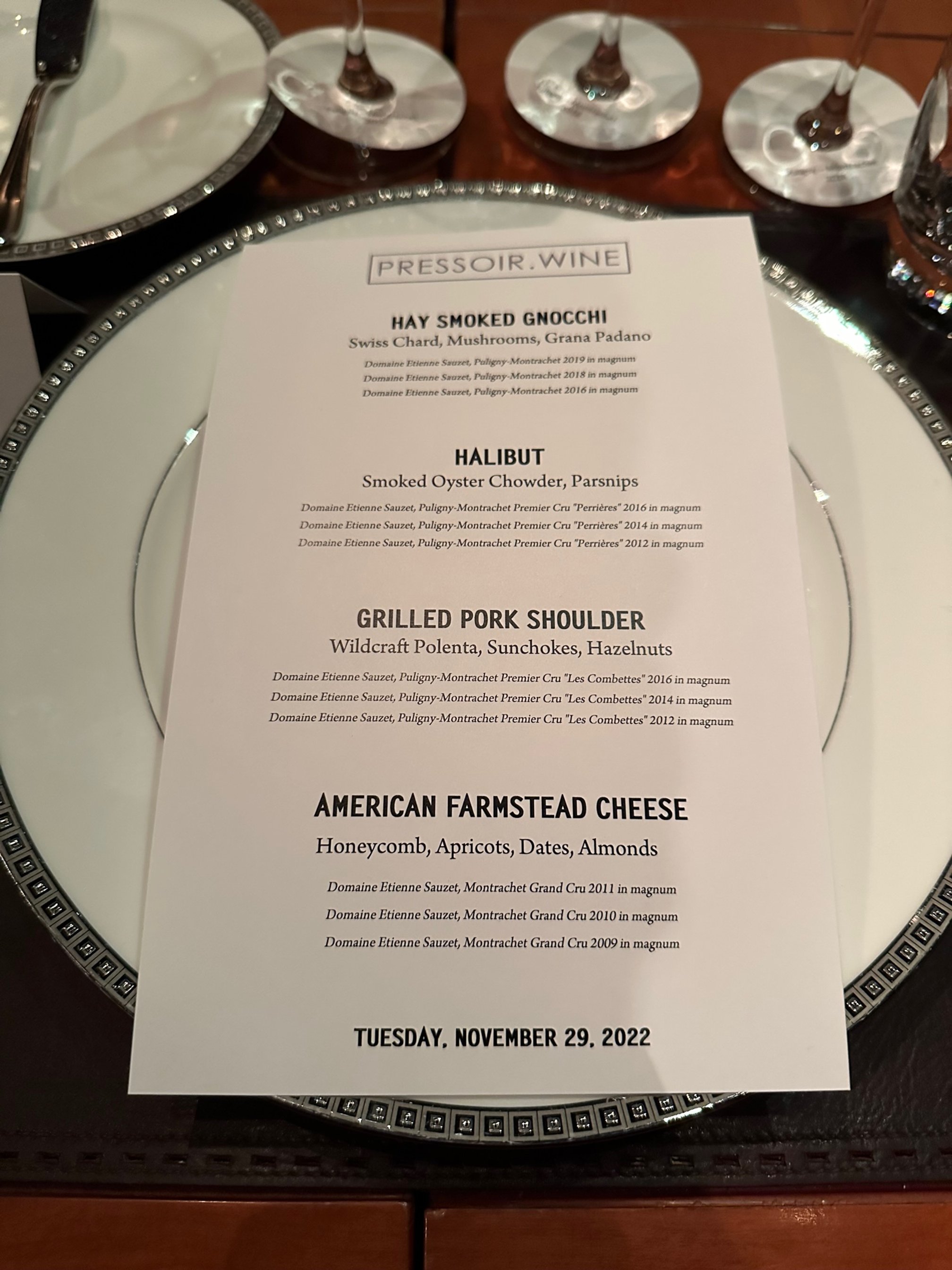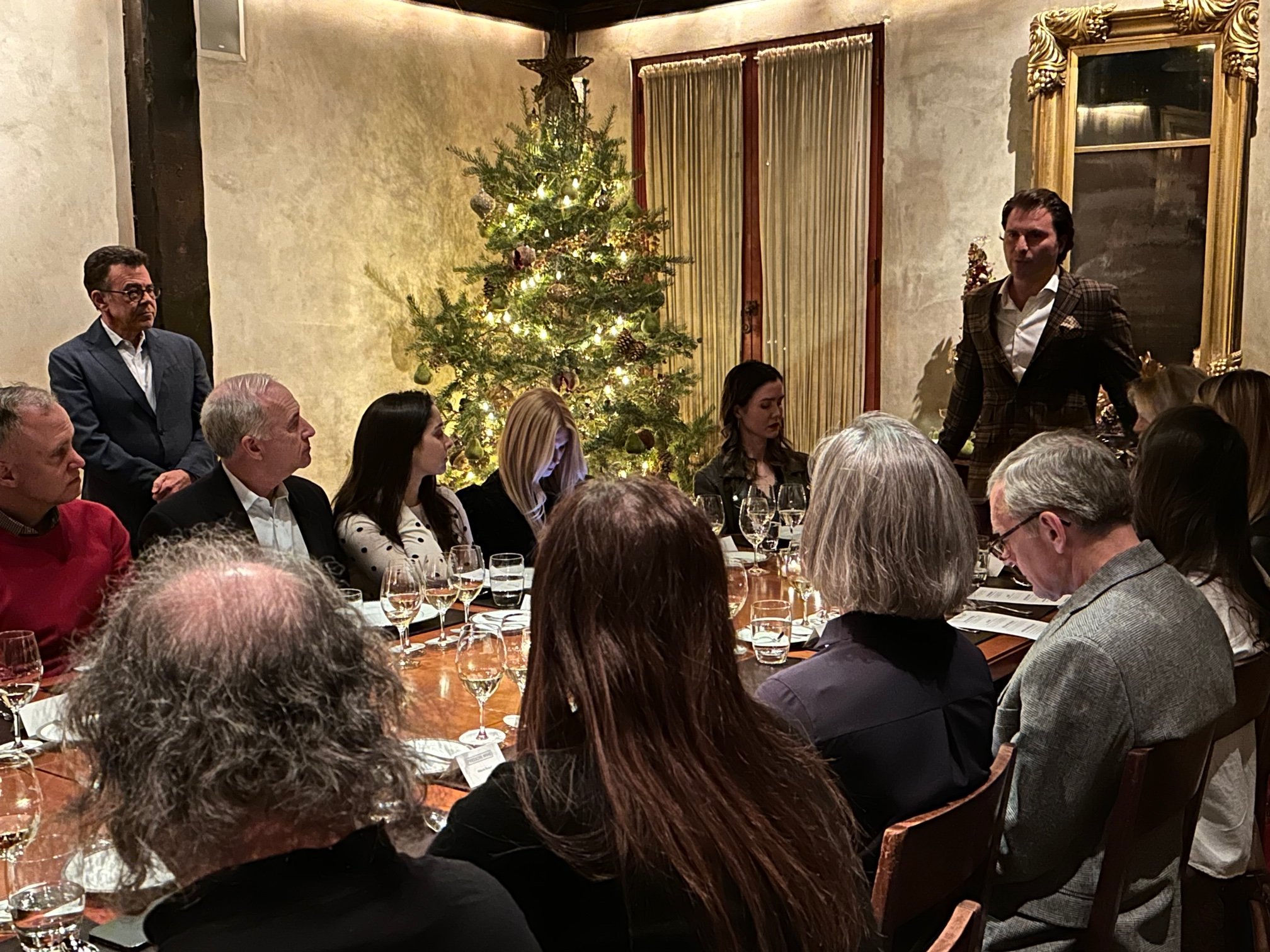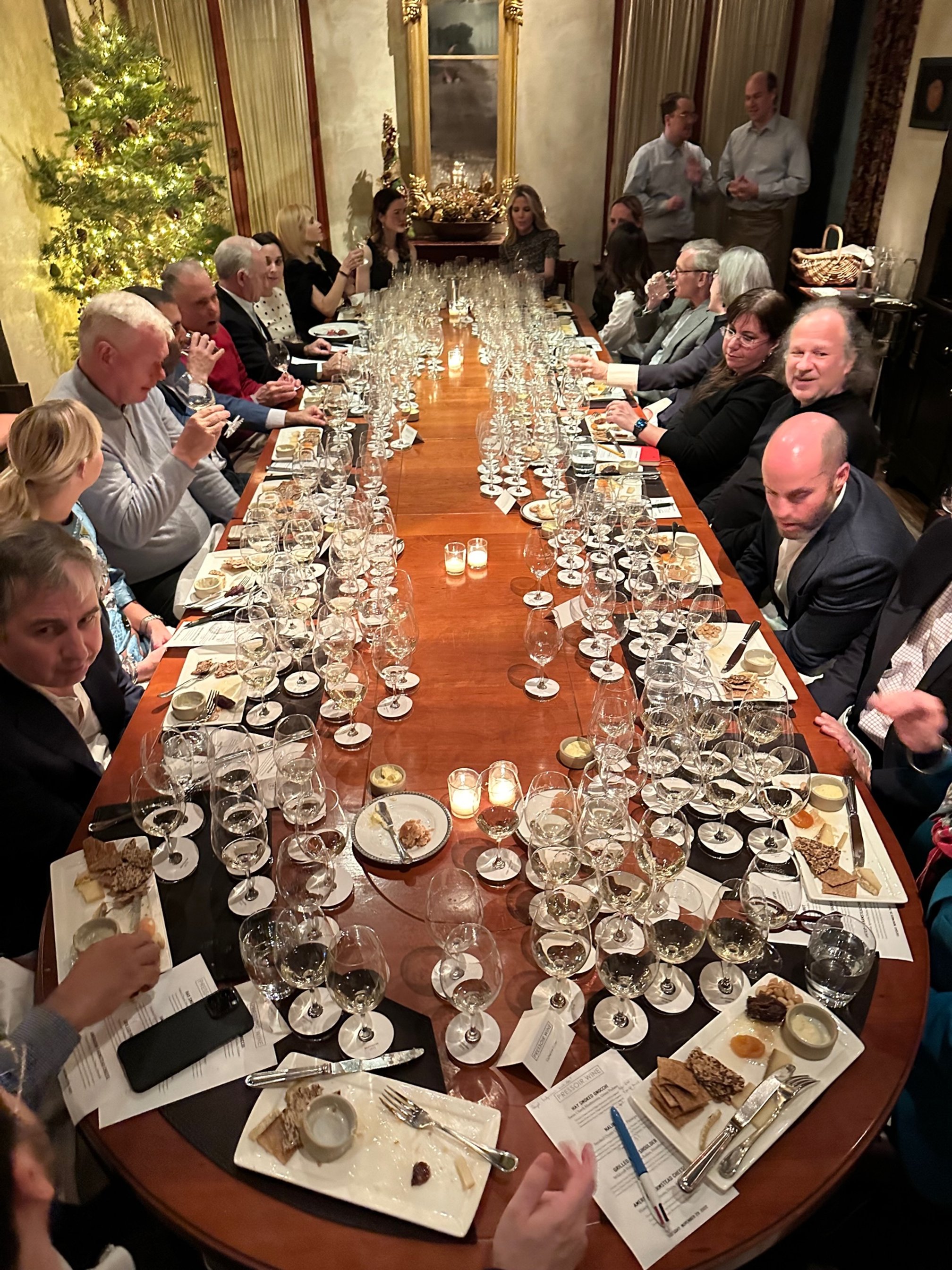The Press
We created The Press to house original content, as well as pertinent, interesting media from our friends and partners, exclusively for Pressoir Club Members.
Categories
Pressoir.wine Dinner Recap - Etienne Sauzet
by Edouard Bourgeois
November 30, 2022
by Edouard Bourgeois
Wednesday, November 30, 2022
It was great to use the charming private room of Gramercy Tavern for the first time
We have hosted several Champagne dinners, but it had been a long time since we put together a dinner entirely around white wine. In fact, the last time was at Marea in July of 2019 and I can still taste Preuses 1995… It was really nice to revisit white Burgundy exclusively through the superb wines of producer Etienne Sauzet. The Puligny-Montrachet estate started bottling under this name in the mid 1950’s and I have been lucky to follow the evolution of the style since the beginning of my career while working as a sommelier in Reims, Champagne. With the current fourth generation, led by the dynamic couple Emilie Boudot and Benoit Riffault since 2002, the farming has been converted to organic and fully biodynamic, starting in 2010. I was also really excited to focus on Puligny-Montrachet, a wine that is typically not really well represented on wine lists. If we can think of at least a dozen producers in the neighboring villages of Chassagne-Montrachet or Meursault, Puligny, smaller in size with just 235 hectares of vineyards, is led by just a handful of domaines. Etienne Sauzet is certainly one of them, among others such as Domaine Leflaive of course, the Carillons or Paul Pernot.
Puligny-Montrachet offers a great opportunity to understand the classic geological and topographical landscape of Burgundy. The vineyards are mostly facing east, some of them slightly turned towards the warm southern sun. The village wines are nicely tucked at the foot of the hill, producing generous wines while the Premiers Cru vineyards are all aligned mid-slope. Although small in size, Puligny proudly hosts no less than four Grands Crus, among them of course, Montrachet.
And did you know? There is an anecdotic production of red wine in the village. About 1% of the production assured by producers Jean Pascal or Jean Chartron and his Clos du Cailleret. When Dr. Lavalle wrote his book in 1855, quite a few of the famous vineyards in Puligny-Montrachet were producing reds, and these vineyards were therefore not included in Lavalle’s classification of the white terroirs.
This being said, Puligny is clearly a white wine village that distinguishes itself from its famous neighbors, Chassagne-Montrachet and Meursault.
Below are my tasting notes from last night’s dinner:
1st flight: Puligny-Montrachet vertical – 2019/2018/2016
All wines were served out of Magnums!
2019: Impressively light on its feet, considering the warm temperatures of that vintage. I loved that wine, and this was a beautiful way to start. Lovely lemony notes coated with a generous mouthfeel that reminded me of a lemon custard and meringue tart.
2018: Although I found a bit less definition in this 2018, I appreciate how the vintage, here again, showed its colors. The confit orange gave an interesting accent, but the heat was present in the long finish.
2016: We are very grateful to have been able to pour this rare wine, especially from a magnum. 2016 was the year famous for a historical frost. The crop was extremely low and the vintage almost impossible to define as the little amount of wine made varied in quality across the Cote. This bottling remained fine and elegant with a touch of herbaceousness.
2nd flight: Puligny-Montrachet 1er Cru Les Perrieres 2016/2014/2012
“Perrières”, a famous terminology in Burgundy typically refers to stony soils
With this second flight, we went up the slope in vineyards characterized by a lower proportion of clay and marls while getting closer to the bedrock of limestone.
2016: Again here, 2016 showed a bit of a vegetal profile but I found it quite pleasant with notes of green tea leaves and a refreshing lactic, yogurt-like mouthfeel.
2014: Another complicated vintage marked by a rollercoaster of temperatures and intermittence of rain and sunshine. I typically really enjoy 2014 whites and was pleased with this Perrieres although I didn’t quite find the acidity I expected on the finish.
2012: The low volumes produced that year were blessed with fine quality. It should be noted first that this is a 10-year-old wine so the nature of the vintage alone doesn’t suffice to judge its performance. I found that age served it well, developing noble bergamot aromas with a beautifully integrated smoky touch. However, I was a bit distracted by a green touch reminiscent of asparagus.
3rd flight: Puligny-Montrachet 1er Cru Combettes 2016/2014/2012
“Combettes” or little combes refers to the small valleys naturally carved through the Côte during Ice Age
Combettes usually tastes a little fleshier and more generous and when tasted at the winery, is poured after Perrieres. In fact, the two vineyards share a border, with Combettes up the slope, overlooking Les Referts and a direct neighbor of Meursault 1er cru Charmes.
2016: This was probably my favorite 2016 of the night with a well-managed creaminess that provided just enough texture without being ponderous. Interesting to think of the proximity of Meursault as a possible terroir influence.
2014: Superb wine. I was pleased to find the 2014 style I love. Energetic and zesty, the wine offered layers of delight.
2012: Back to a vegetal nose confirmed by this asparagus on the palate I had in the previous 2012. Not my favorite wine of the night but still a very pleasurable bottle that held proudly through almost a decade of bottle age.
4th flight: Montrachet Grand Cru 2011/2010/2009
The one and only Montrachet
Considered to be one of the most exquisite vineyards in the world, Montrachet is often described with superlatives. This twenty-acre Grand Cru, divided among sixteen owners, is always a show stopper. Note, Etienne Sauzet does not own plots in Montrachet and does purchase grapes. From who? That is an information no one could give me.
2011: It is easy to feel disarmed when the expectation is so high, and that is exactly what happened here. When I first tasted right after opening, I thought the wine was shy, an adjective I thought I would never use to describe the authoritative Montrachet. But patience paid off. After tasting it again with a few hours of oxidation, the complexity unveiled captivating aromas and the unmistakably long finish of Montrachet.
2010: The true show-stopper. Untamed, the explosive nature of this wine jumped out of the glass, lavish and opulent. But the real magic and uniqueness of Montrachet is its ability to be focused and balanced, despite its massive personality. Like other superior wines, the depth of aromas leaves the taster speechless and forced to close one’s eyes to taste this enchanting terroir.
2009: Tasting Montrachet is always a privilege, but being lucky to taste a vertical is a real treat. Comparing 2009 and 2010 was fascinating. If I did prefer 2010, I thought 2009 was magnificent. Sure, the alcohol felt higher and the power was at the forefront but again here, the strong terroir was instrumental in creating the necessary balance and profound aromatic complexity.
No red wine? No problem!
Legend Dominique Lafon Officially Retires
News from the vineyard
by Edouard
1/19/22
After nearly 40 years at the helm of Domaine des Comtes Lafon, Dominique Lafon has hung the pipette and has officially retired from his function as winemaker of the legendary domaine. His daughter Léa and his nephew Pierre are the new generation in charge of the iconic estate. Dominique launched a separate négociant business in 2008 under the label “Dominique Lafon” and he will focus on that project from now on. The Lafon family established itself in Meursault as far back as the late 19th century. Back then, it was Jules Lafon, Dominique’s great grandfather, who was wise enough to buy some of the best plots in the appellation, including a spot in the supreme Montrachet Grand Cru.
Dominique certainly inherited a prime domaine but his personality, talent and hard work proved that he was the right person to take over in the early 1980’s. Always questioning himself, he continually experimented and faced challenges such as the tricky premature oxidation white Burgundy started to struggle with thirty years ago. His honesty and open mind pushed him to consistently try to tweak details here and there. For example, Dominique decided to switch to biodynamic practices entirely. He also switched to using exclusively Diam corks for the whole production with the 2013 vintage. A visionary, he was also among the first ones to look outside of his hometown of Meursault, starting with the southern tip of Burgundy where, in 1999, he bought great parcels in the Maconnais where his wine label “Héritiers du Comte Lafon” still produces delicious and zippy whites. Dominique also consulted for wineries around the world, in Oregon for example, at Evening Land and more recently with MS Larry Stone of Lingua Franca.
Our team decided to honor the man with a wine dinner last week and to change things up a bit, we thought of pairing his Meursault and Volnay with the superb food of Korean joint Atoboy. The lineup was very successful and flawless.
The three first courses were built on three verticals of 2012, 2009 and 2007. First with Charmes, then Genevrières and finally the unmistakable Perrières.
Overall, I was particularly impressed with the 09’s. Such a warm year typically meant Chardonnays that lacked acidity and freshness. Not at Lafon. all three Meursault were really clean and airy without great texture. 2012 is a strange vintage for white Burgundy and impossible to judge as a general style for the region. Although, if there is one common thing to say for all producers is that they struggle with challenging weather conditions, reducing their yields dramatically. Once again here, Lafon struck gold with wines that are singing and pure. The Genevrières really displayed the floral tones it is famous for.
Finally, 2007 kept its promise of a great vintage. I adored the mouth watering quality of the wine where the acidity makes you salivate but the sugar immediately coats your palate, leaving an irresistible fruity, candy feeling.
It was also a fascinating educational experience to distinguish the difference between Charmes, Genevrières and Perrières in such an ideal context.
Moving on to the reds, the focus was on the 2009 vintage, covering three Volnay climats: Champans, Clos des Chenes and Santenots du Milieu. Once again, each climat was true to its identity, with Champans exhibiting a lighter profile and delicious small red fruits, Clos des Chenes perfectly balanced and aromatic while Santenots, the “hybrid” climat that also covers the Meursault appellation, was tighter and more tannic.











